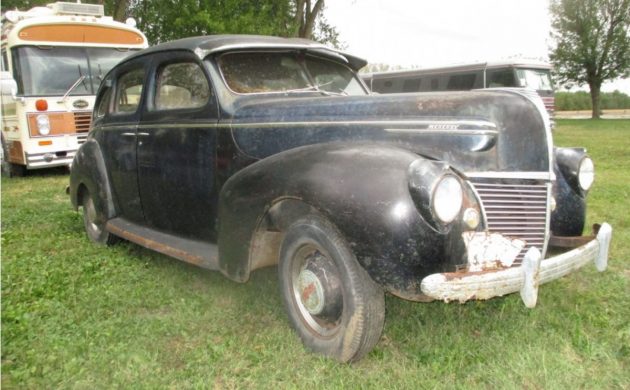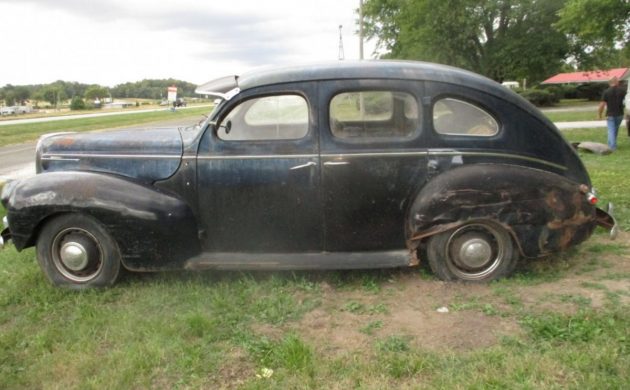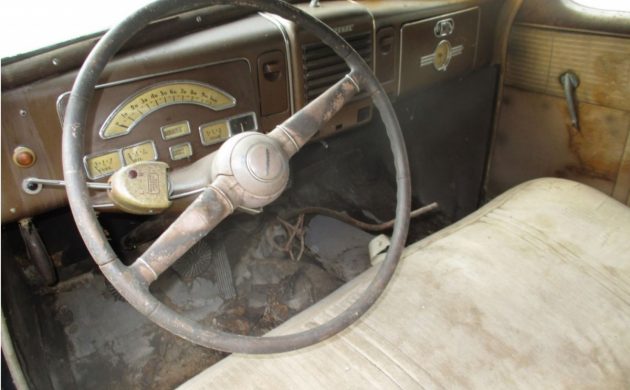Launching a completely new car brand will be a high-risk venture at the best of times, but doing so as the world was slowly climbing out of the crippling Great Depression was a supreme act of bravery and self-belief. That is precisely what happened when Edsel Ford decided to form Mercury in 1938, with its first offerings hitting the market for the 1939 model year. Our feature car is a Mercury Eight Sedan from that first year of production, and it looks like it could make a fantastic family or first restoration project. It is solid and complete and is waiting for the right person to return it to its former glory. If you like what you see, you will find the Mercury located in Taylor, Missouri, and listed for sale here on Barn Finds Classifieds. It represents an affordable project car, and you could park it in your workshop for $6,000.
When it was launched, the first Mercury didn’t wear any badges that designated it as the Eight. However, sales brochures referred to it by this name, and it eventually received the badges in 1941. The company offered a full range of body styles, and first-year sales amounted to an impressive 69,135 cars. For what was essentially a start-up venture in that era, there was no denying that Edsel Ford had made the right decision. The most popular variant was the Four-Door Sedan, which attracted 39,847 buyers. Our feature car is one of those vehicles, and it shows enormous promise as a restoration project. It is complete and appears to be in a structurally sound state. Its rust problems seem to be confined to little more than surface corrosion, and the buyer should have no issues addressing this. The driver’s side rear fender is battered and bruised, but the owner includes a replacement in the sale to give the buyer a starting point. Some of the trim and chrome would benefit from a trip to the platers, but the rest should respond positively to some elbow grease and a high-quality metal polish. There are glass pieces that are becoming cloudy around the edges, but locating replacements will not be difficult or expensive. Overall, whipping the panels and paint into shape looks like it would be a straightforward proposition.
The first Mercurys demonstrated a trend that would continue for the life of the marque. While it was a brand in its own right, its designers and engineers dug into the Ford parts bin for many parts and drivetrain components. Therefore, it is no surprise to find the Eight powered by a 239ci flathead V8 that produced 95hp. Those horses find their way to the road via the rear wheels and a three-speed manual transmission. At 3,003lbs, the Eight was not a particularly heavy car for this era. With that V8 churning away under the hood, it could leave any passenger car offering from its parent company in the shade when it came to the question of outright performance. The fact that it brought added luxury to the table was always going to win it friends among the buying public who aspired to a car with more prestige than anything wearing the blue-oval badge. Our feature car is mechanically complete, and while it doesn’t run, the wonderful flathead does turn freely. The owner has recently installed a new master cylinder and cleaned the fuel tank. He believes that returning it to a running state would not be a huge challenge, and given the bulletproof nature of these motors, I tend to think that he could be right. When you look at the car’s overall condition, it might be possible to return it to a mechanically roadworthy state and hit the road behind the wheel of a genuine survivor.
This Mercury’s interior continues the car’s overall theme of being complete but needing a dose of TLC. Once again, the buyer could throw some blankets over the seats to protect the existing upholstery and drive the vehicle as an original survivor. If the buyer wanted to get serious, restoring this interior would be possible. Returning the wheel to a factory-fresh state would be an easy task to tackle in their workshop. The same is true of the painted surfaces, but components like the gauges seem to be in excellent order for their age. The upholstery might cause the buyer to swallow hard. While complete kits are available, they retail for around $4,000 in the correct color and material if the buyer’s aim is for a faithful restoration. There are cheaper options that they could investigate, but that figure will buy them everything required to return the interior to showroom condition. As I’ve said in previous articles, interior retrims can seem expensive, but if an owner uses the correct materials and completes the work to a high standard, it represents a one-off expense that can serve without issues for many decades to come. It is also worth noting that if the buyer does undertake a faithful restoration to a high standard, the market value of the Sedan could be over $30,000. Considering how straightforward the rest of this project would appear to be, splashing the cash on the interior could make sound financial sense.
For Edsel Ford, the Mercury badge wasn’t merely a name or a way to take on the might of General Motors at their own game. For him, it was essential that the marque was a sales and financial success. While he may have been the President of the Ford Motor Company, his decisions were subject to challenge and change without notice or logic from his father. Edsel was desperate to prove that he was worthy of controlling the Ford empire in his own right, and hovering over him like a vulture was the specter of Henry’s pugnacious side-kick, Harry Bennett. Many who knew both Henry and Bennett believed that Ford had every intention of eventually handing the reigns not to Edsel, but Bennett. Mercury was the success that Edsel craved for, but he sadly succumbed to terminal cancer before he had the chance to lead the company that he and his father had built. History shows that Bennett never managed to take control and that Henry II would lead the company to some of its greatest successes. Mercury was part of Edsel’s dynamic vision for the future, and returning this 1939 Eight Sedan to its former glory would seem to be a fitting way to honor his memory. Are you willing to rise to the challenge?







The ’40s body style appearing as a ’39 was something I never knew. The extra taillights for the turn signals look like Chrysler products. This should be a good project to take on considering the solid state of the frame and body.
Bobhess, I believe the extra taillights are 1949 Hudson.
You sure don’t see many of these around. Personally I haven’t been around a ‘39 Mercury in the flesh. A decent restoration project for sure. A few years ago I wouldn’t have hesitated to take on one of these on but I’m short on resources to complete the projects I already have so I’ll have to pass. But what a ride it would be…
I love the sound of a flathead springing to life, but whoever thinks these things are “bulletproof” never drove one. “Fill up the oil and check the gas?” was what the gas station attendant used to ask me when I’d pull in. You could buy recycled oil in a two gallon can at the time and I always had a gallon or two on hand. They ran hot and were hard starting. I spent more time rolling these old beasts down the driveway and popping the clutch than pushing the starter button. I had two 46s, two 47s, two 50s and currently have a 48 tudor. The current one and one of the 47s were the only ones that started and ran right. If you were a dumb teenager trying to chirp the tires on takeoff, you were likely to twist a woodruff key in the rear axle or tear the first-reverse slider out of the trans. But the first 46, a beat up, rusty coupe cost me 20 bux in 1964 and you could drive one til it dropped and pick up another one for 50 bux on most any street corner. Still, I love them!
If someone had used 1940 headlight assemblies in the upgrade to sealed beams, the front end would look a lot better.
Personally, I think I’d want to “retrofit” the 1939 headlamp assemblies. Beyond that, I’d love to keep something like this as a survivor, cleaning and maintaining… and enjoying it!
I’m more interested in the RVs behind it.
George-The one behind this car is a 1982 Bluebird Wanderlodge 35 Foot Motor Home with 100,549 original miles and it has been sold. The other one is a 1986 Newell 40 Foot Diesel Pusher Motor Home with 170,000 original miles and its for sale for $40,000. To view additional photos of the 1986 Newell, go to http://collectorcars.fotki.com
This car and Batman “born” in the same year. Perfect!
This was my Dad’s first car. He got in high school when his Dad died.
Wayne. I believe you are correct. Didn’t think deep enough.